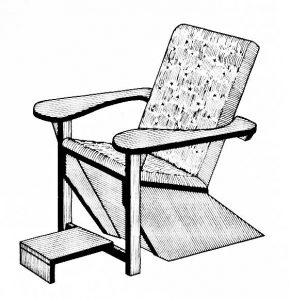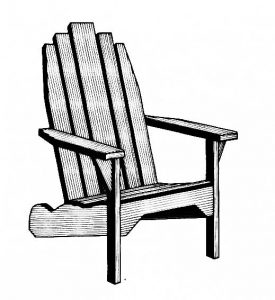Small Home Gazette, Summer 2020
The Adirondack Chair—a Lawn Classic
After more than 100 years of popularity, the Adirondack chair has earned heirloom status. The chair’s history began in the Town of Westport, New York, with the inventor of the Westport chair—Thomas Lee. Lee wanted an outdoor chair for his family’s home that would be sturdy, balanced and comfortable on the rugged terrain of the Adirondacks.
For several years, Lee worked on his design, having family members test each version to refine it. By 1903, Lee had a final design, consisting of a chair with wide armrests, a high back, and a slanted seat. The back and seat were made from single pieces of wood. He called it the “Westport chair.”

Harry C. Bunnell’s design, 1905. Drawing by Mary Reilly.
Harry C. Bunnell, a friend and local carpenter, saw the commercial value, and Lee gave him the design. Burnell began to build and sell the chair. His only modification was to make it a little narrower. In 1905, Bunnell was granted a patent for “a chair of the bungalow type adapted for use on porches, lawns, at camps, and also adapted to be converted into an invalid’s chair.” His patent sketch shows a chair with the general outline we know today.
Bunnell made the chairs in upper New York state, during the first two decades of the century. The Westport chair grew in popularity because of its durability and high comfort level (many were purchased for resorts and camps), but as the years passed, the design began to change.

The Sears, Roebuck & Co. version, 1932. Drawing by Mary Reilly.
It was difficult to mass-produce chairs made from a single, knot-free plank. Design changes introduced a seat and back made out of multiple slats of wood, lined up, while retaining the wide armrests, high backs, and slanted seats.
The updated design contributed to even more popularity, and the chair became widely-known as the “Adirondack chair.”
In 1932, Sears, Roebuck & Co. introduced the chair and a companion settee (painted in orange and green) in a colored catalog illustration as “The Very Latest Wood Lawn Furniture.” Sears made its version from “selected hardwood” and charged just $3.98.

Vintage Adirondacks travel poster
In 1938, Irving Wolpin of New Jersey acquired a patent for another design change. Described as a “lawn chair,” Wolpin’s chair had the slanted seat and wide armrests of the Westport chair, and was constructed out of smaller slats, but also featured a rounded back and contoured seat. Wolpin’s design is the most commonly replicated Adirondack chair today.
Through the 1930s, the chair spread across the country, both through the Sears catalog and through firms that offered kits for home assembly. By the 1940s, it had become a lawn and beach fixture. Although it exists in many forms today, each one is still inspired by the original Westport chair.











